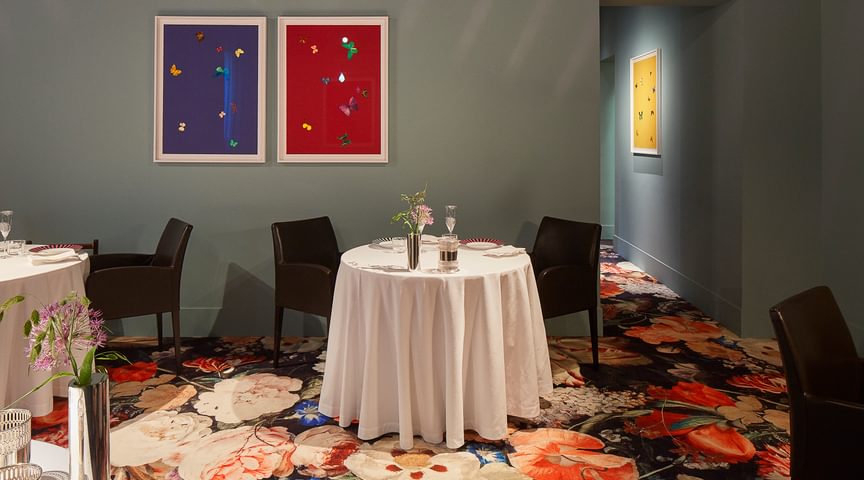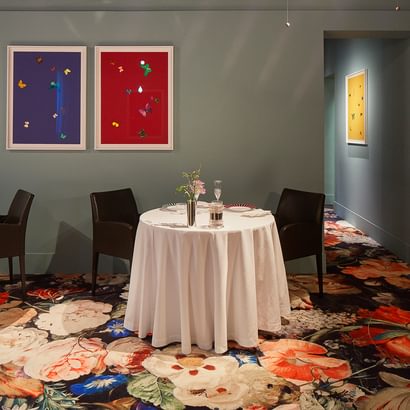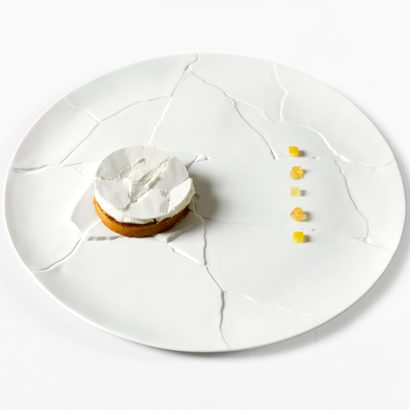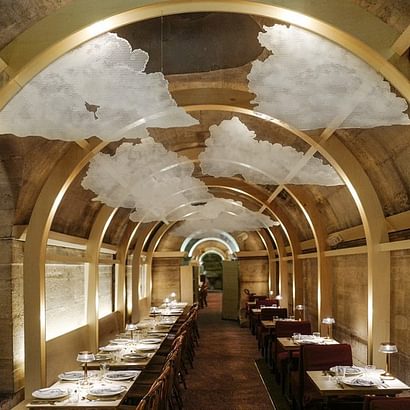
December 06, 2021
A taste of humanity
Lara Gilmore ’86’s refettori are no ordinary soup kitchensby Rita Savard
Pull up a chair, let the world slow down, savor the meal—and the company.
An old Italian proverb might explain it best: A tavola non s’invecchia: “At the table with good friends and family, one does not grow old.” Words to live by for Lara Gilmore, who knows a thing or two about the transformative power of food.
The co-owner of Modena, Italy’s Osteria Francescana—awarded three Michelin stars since 2012 and twice named World’s Best Restaurant—is fighting food waste with her chef husband, Massimo Bottura, and changing the conversation on food.
The power couple launched a social enterprise in 2015. Food for Soul redefines the possibilities of soup kitchens. But make no mistake, Gilmore advises, flashing a thousand-watt smile. This is not a charity project. It is a cultural one.
There are now 13 refettori (Italian for dining halls) worldwide, including two that opened in the United States this year. Refettorio Harlem in New York, which has been providing meals to the community throughout 2021, will open its doors to the public in mid-December, and Refettorio San Francisco currently serves meals in a temporary space while searching for a permanent home. All shine a light on making the most of surplus food.
“The word refettorio,” Gilmore explains, “comes from the Latin reficere, meaning to ‘remake,’ but also to restore. It was originally a place where monks gathered to share their daily meal.
“We wanted to focus on rescuing food and show people how you can make truly delicious meals out of what would otherwise be thrown away by grocery stores, markets, and catering companies,” Gilmore says. “But we also wanted to address beauty at the refettorio. Hospitality and how you welcome someone—how they feel in their environment—is just as important as what you’re serving them at the table.”

Food for Soul restores and renovates neglected spaces, transforming them into inspiring community hubs. By partnering with artists, architects, designers, and musicians, Gilmore and Bottura are building a movement in which people in vulnerable situations—as well as the whole community—can feel welcome and valued.
“Imagine a beautiful space, filled with art, music, and good conversation,” Gilmore says. “This sparks social connections. Not just for the people in need, but for the volunteers, the chefs—everyone walking through the doors and joining the gathering. It brings them all together in an equal way. And everybody is raised up a little bit. That is the power of food. We think of food as delicious meals, but food—and the act of coming together around a table and creating a dialogue—transforms how we feel about ourselves.”
Food is both a teacher and a storyteller. One life-changing lesson—and quite possibly the genesis of Gilmore and Bottura’s food revolution—harkens back to 360,000 wheels of Parmigiano-Reggiano cheese.
Northern Italy’s Emilia-Romagna region, known for its balsamic vinegar and Ferrari sports cars, was not prepared for the destruction caused by an earthquake that hit Modena in 2012. The local dairy-farming community was pulverized and hundreds of thousands of damaged cheese wheels were destined to be thrown away—until Bottura and Gilmore stepped in, masterminding what is now known worldwide as “The Great Parmesan Rescue.”
Featured in the opening episode of the Netflix documentary Chef’s Table, Bottura developed a technique for cooking risotto in cheese to get chefs to buy the damaged wheels. With Gilmore’s communications savvy, they hosted an online fundraiser since dubbed the “biggest Italian dinner in history” on social media.
The easy-to-make and delicious recipe made it into home kitchens and culinary hotspots alike all around the world. Every cheese wheel was sold and the industry was saved.
“It was eye-opening,” Gilmore says. “Chefs are realizing they have a voice, and with that voice is an opportunity to make change.”
She points out that we’re at a critical moment. Almost one billion tons of ready-for-sale food gets wasted every year, most of it at home, according to the United Nations Environment Programme, for which Bottura is a goodwill ambassador.
We want to communicate that wasting food is not ethical and show people how they can get creative and have real impact.
”The first refettorio was born as a pop-up concept at the 2015 Food Expo in Milan. Housed in an abandoned theatre, the community kitchen brought together more than 60 international chefs to cook using food leftovers from the Expo. During the six months of the event, 100 volunteers washed dishes, mopped floors, and served over 10,000 meals cooked from 15 tons of salvaged food. Today, the Milan refettorio still serves healthy meals in a beautiful space five days a week.
The project has grown and flourished in cities across the globe, with each location—a historic colonial house in Yucatan, Mexico; an ancient crypt in the heart of Paris; a 100-year-old Gothic-style church in Harlem—boasting its own unique character and style.
“Like the finest dining rooms in the world,” adds Gilmore, a fine arts major, “the refettori are places where food and hospitality combine with art and culture. It is also about bringing dignity to the table, which can be done in many ways—through the power of beauty, the quality of ideas, and the value of hospitality—something we’ve learned over our 26 years of experience at Osteria Francescana.”
The wild success of the Modena restaurant, a 12-table, 34-seat intimate affair in a small town, has allowed Gilmore and Bottura to wield influence over issues they care most about and combine their love of community, art, and food to lead the charge on social impact entrepreneurship.
Three years ago, Gilmore and Bottura launched Tortellante, a project that teaches people with special needs how to make tortellini. Paired with veteran Italian pasta makers, students ages 16 to 25, including their son Charlie, produce tortellini daily for local restaurants, cafeterias, and businesses (including a Maserati car factory). The students gain both skill and pride for contributing to their town’s culinary identity.
When the pandemic made it impossible for the U.S. refettori to open their doors to the public, both locations—along with established refettori around the globe—transformed into brown bag delivery services for the most vulnerable. In Harlem, an average of 600 meals a week are still being delivered to those in need.
“The past couple of years has reminded us how strong we are when we work together,” Gilmore says. “We will always be a community gathering around a table of family, friends, and strangers who will become friends. Food is the binding force that draws us together and reminds us of our collective humanity.”
Top photo by Paolo Terzi.
5 Questions with Lara Gilmore ’86
What is the one thing in your kitchen you cannot live without?
Parmesan cheese. It’s true! That and a good balsamic vinegar.
You own a restaurant, and you live in Italy so of course we must ask: What is your favorite wine?
Emilia-Romagna’s Lambrusco—Lambrusco is the name of both the grape and the Italian red wine made from the grapes, which are grown here in Modena. This is not a wine that ages. It’s served fresh, often chilled, and sparkling, and there are different variations from a light rose’ to a dark red. It’s my go-to daily glass of wine with dinner. My favorite white is also from grapes grown here in the Emilia-Romagna region, on the hills of Piacenza. The wine is produced in small batches by La Tosa and has a beautiful name, Sorriso de Cielo, which means “Smile from the Sky.” The first time I drank it, I had just arrived in Italy and Massimo took me out for dinner, when we both tried this wine for the first time. I fell in love with it, and with Massimo, of course, and both have been a regular part of my life since 1993. This is the power of food and drink linked with memory. Every time I enjoy this wine, it’s a beautiful reminder of Massimo and I over all these years—getting through, curving, and creating together.
Of all the places you’ve travelled, what has become your most unforgettable food memory and why?
As an American, the first trip I took to Europe was in 1982 when my father exchanged houses with another editor who had an apartment in France—a very cool 1960s contemporary design that was very different from our bucolic home in Westchester, New York. That was also my first experience going to a food market and buying just what we needed for a day. The encounters with artisans and food producers and seeing the faces of the vendors—like the women selling the olives or the rose’ my parents were drinking—created a whole new connection with food.
Another memory—a stark contrast but one that remains vivid nonetheless—is a trip to Russia in 1991, after the Berlin wall had come down. We were in Moscow, and I will never forget the feeling of scarcity of food. The lines of people waiting for something to eat; basic foods like bread and eggs being rationed. It was the first time I had ever seen anything like that, and the experience gave me a deeper understanding and appreciation of the importance of food, and what it means to have access to it.
Who is the person who has influenced you most?
My dad, Ken Gilmore (former editor-in-chief of Reader’s Digest). He was a very hard worker. A perfectionist who went all in on his projects, it took him a long time to do things whether he was editing a piece or writing a speech. I can still see him hovering over his desk with three different colored pencils—a blue one, a red one, and a brown one. He had this sense of being methodical and never giving up, and he knew how to bear his own difficulties and keep people together to create the best magazine possible. I learned so much from him. Work ethic has always been the key to our success. That, and understanding and appreciating the strengths, skills, and power of the people we work with. Trust, respect, and love. We’re all in this and growing together.
What is your favorite dish Massimo makes?
He makes this dish that has become iconic—Five Ages of Parmigiano Reggiano in Different Textures and Temperatures. We didn’t own the restaurant when I first tried this dish. It was in an infantile state, with just three different temperatures and textures. But an early instinct for Massimo was to highlight Emilia-Romagna, where he is from. He was determined to make his own recipe using parmesan cheese from the region and have people experience it in a whole new way. It was a tone poem with one note and as the years passed, we brought this dish with us and created two other textures and temperatures, making it deeper and richer. This one beautiful dish is not only delicious, but it also talks about landscape, slow food, the history of the country, and identity. Every time I present it, I am still amazed by the power of intuition and how nurturing an idea and a dream over time can put a face on something—even a cheese.

































